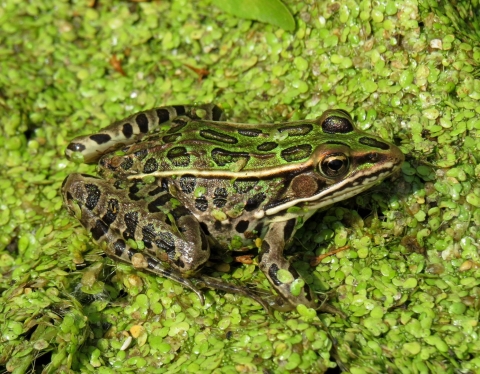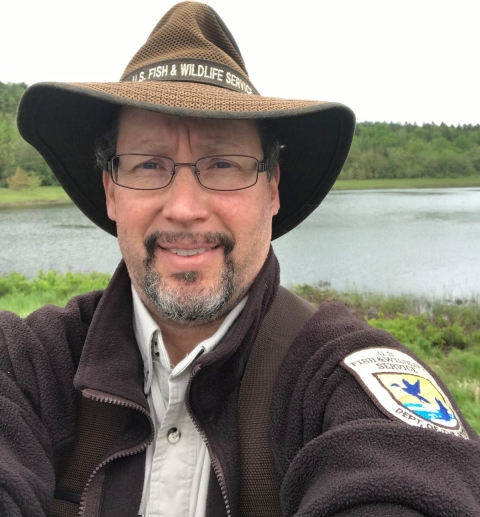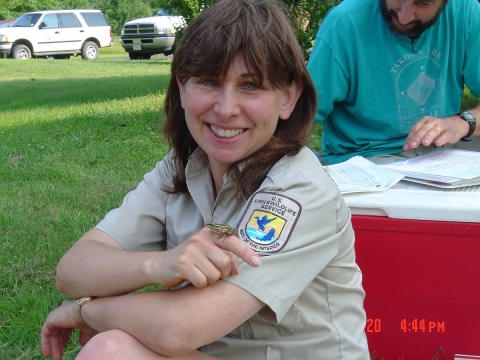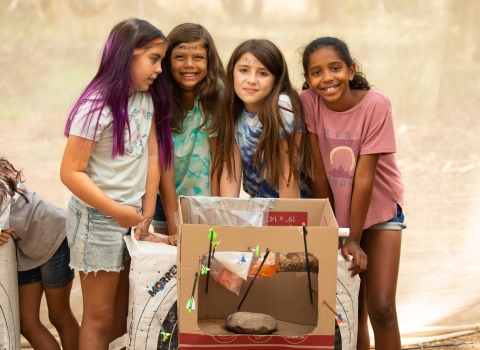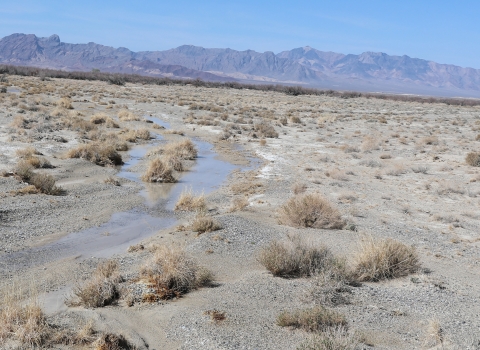Perhaps the most beloved and talented amphibian ever, Kermit the Frog charms us all as he strums a banjo and croons “Rainbow Connection.” It’s Muppet magic at its best. This time of year, the evening air is filled with simpler, but no less entertaining, frog song, as Kermit’s kin throughout the Northeast woo mates and defend territories with full-throated calls. No banjos necessary.
To each their own
Like birds, only male frogs sing, and each species has its own song. Frog calls span the musical scale from soprano to bass and range from sweet to sonorous. The calls of many individuals, and sometimes various species, often blend into a chorus.
Unlike birds, frogs sing without opening their mouths, pushing air from the lungs through the larynx, across the vocal cords, and back again. Some have vocal sacs on their necks, which also fill with air and amplify the song.
Frogs offer a study in phenology, or the timing of natural events. Some species begin singing as soon as winter cedes to spring and nighttime temperatures reach 45 degrees Fahrenheit. Others wait for warmer weather … and some aren’t ready to chime in until nights are a balmy 70 degrees.
To hear frog calls, drive around your local roads, with windows down, about 30 minutes after sunset. Chart a route ahead of time that will take you past shallow wetlands, such as swamps, marshes and ponds. Wooded areas may have small depressions that fill with water in spring — called vernal pools — that attract species like wood frogs.
It helps to learn mnemonics, or memory aids. The following species are found throughout the Northeast. They’re listed in order of annual appearance, with descriptions of their calls:
- Wood frog: quacks like a miniature duck
- Spring peeper: a loud, bird-like, piercing “peep”; a large group sounds like jingling bells
- Leopard frog: a drawn-out, rattling snore, usually followed by a soft chuckle.
- Pickerel frog: a steady, low-pitched snore, with an occasional “guck!”
- American toad: a long, musical trill
- Gray treefrog: a short, musical trill
- Fowler’s toad: a nasal, buzzy trill that sounds like a baby crying
- Green frog: an explosive, throaty “GUNK!”, followed by “gunk, gunk,” lowering in pitch and volume; like a loose banjo string
- American bullfrog: like a cow’s moo or “jug-o-rum, jug-o-rum, jug-o-rum”
Scientists have noticed that some early-spring singers are heard even earlier in recent years, perhaps due to a warming climate. Research has shown that calls within the same frog species vary with altitude, being shorter and higher pitched at the base of a mountain, where temperatures are warmer, than at the top. Some wonder if climate change climate change
Climate change includes both global warming driven by human-induced emissions of greenhouse gases and the resulting large-scale shifts in weather patterns. Though there have been previous periods of climatic change, since the mid-20th century humans have had an unprecedented impact on Earth's climate system and caused change on a global scale.
Learn more about climate change will have the same effect.
Bringing her work home
You don’t need to be an expert to listen for frogs and contribute to their conservation. In fact, surveying frogs is a wonderful family activity that promotes scientific discovery.
Nancy Pau, wildlife biologist at Parker River National Wildlife Refuge in Massachusetts, created a county-wide frog survey on iNaturalist and encouraged her community to participate.
“My boys and I love learning different frog and bird songs, trying to guess who’s calling when we hear a song,” said Pau. “It’s fun to drive around just after dark and listen to what frogs are calling around our neighborhood.”
Pau enjoys crossing paths with other families searching for frogs and salamanders.
“It always lightens our hearts to see a kindred frog hunter,” she said.
Gateway wildlife
You never know where a fascination with frogs might lead.
Ray Brown, supervisory wildlife biologist at Northern Maine National Wildlife Refuge Complex, can trace his attraction to wildlife back to the frogs of his childhood.
He recalls fondly the spring peepers, eastern American toads and American bullfrogs calling near his family farm in rural Maine.
“My mother bought me a vinyl record of the calls of frogs and toads, and another one of the calls of birds, so I could learn what animals were making the calls and songs I would hear in the springtime,” he said. “I would listen to those records over and over on the turntable on the credenza in our dining room, much to the annoyance of my siblings who wanted to listen to music instead.”
Laura Eaton, assistant regional biologist, used to collect frogs in the swimming hole at her home in upstate New York.
“My brother and I and the neighborhood kids would haul a canoe around, wading up to our knees in the mud, and catch as many frogs as we could, plopping them into the canoe,” she said.
They would then sort them by species: Daddy frogs (bullfrogs), Greenies (green frogs), Friskies (pickerel frogs), and from the lawn around the pond, Grandpa toads (American toads).
“When it was time for dinner, we would tip the canoe over and return our quarry to their home so that we could catch them again another day.”
Though not as mainstream or lyrical as Kermit, wild frogs fill the evening air with song in the spring and summer months. Their voices are indicators of our planet’s health and soothing soundtracks to outdoor activities.


